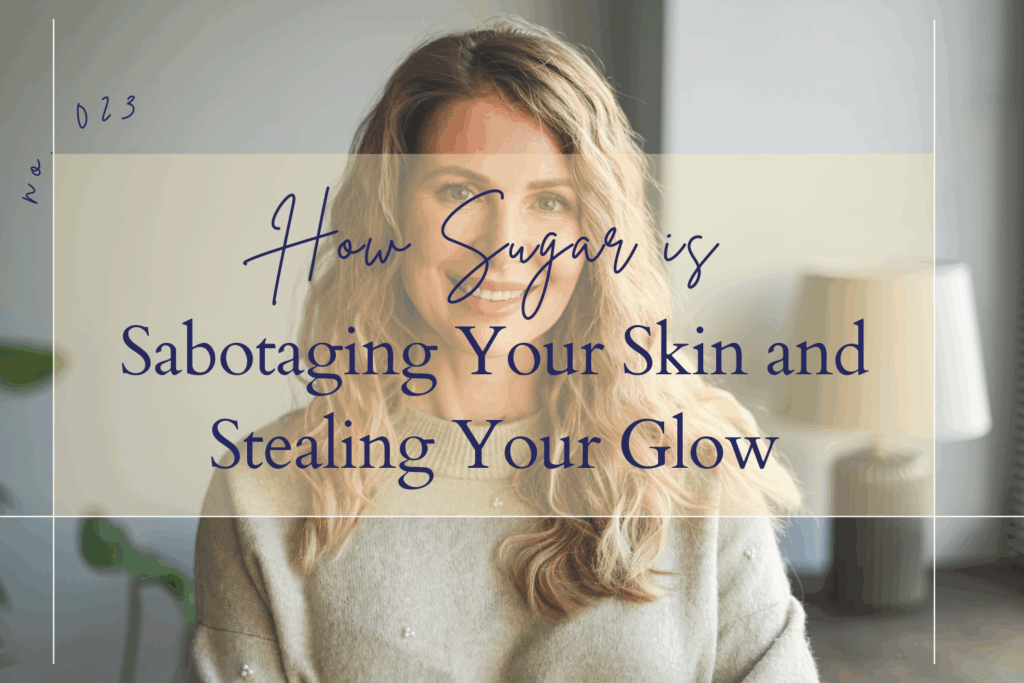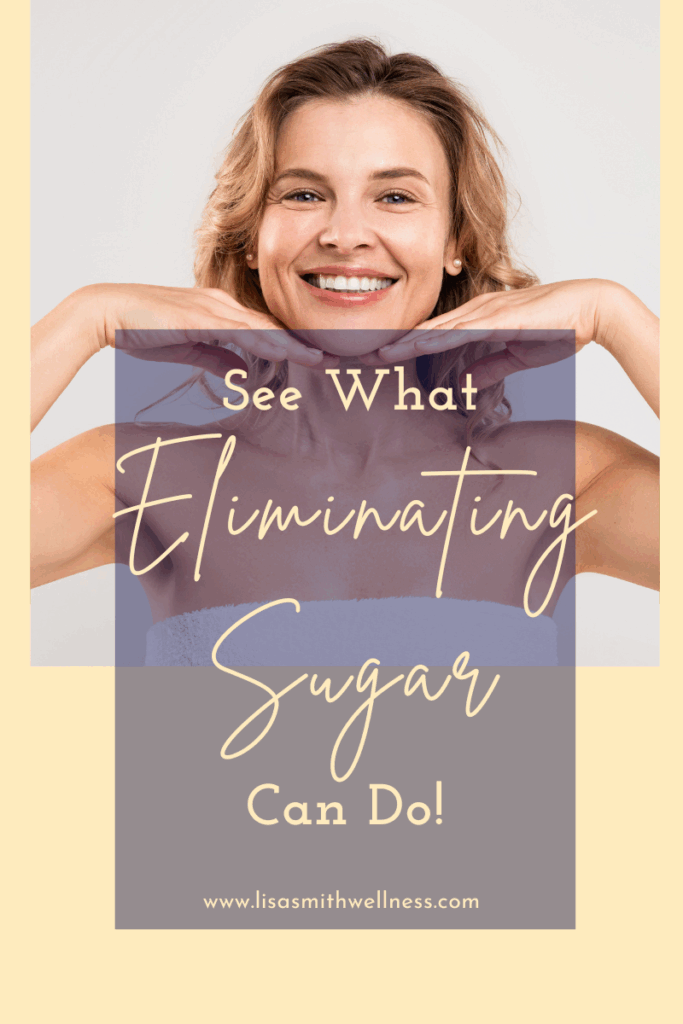Let’s cut to the chase: sugar isn’t just hiding in your favorite snacks; it’s out here stealing your glow, aging your skin, and tanking your health faster than you can say “just one bite.”
You’ve probably heard that sugar isn’t great for you—but what if I told you it’s actually one of the biggest culprits behind inflammation, breakouts, fatigue, and yes, those pesky fine lines that seem to show up overnight?
And the kicker? It’s everywhere. Even in that “healthy” granola you’re sprinkling on your smoothie bowl with smug satisfaction.
So grab your green juice (no shame, just check the label), and let’s dig into the sticky truth about sugar—why it’s aging your face, draining your energy, and how to take your power (and your glow) back.
This post contains affiliate links meaning I make a small commission at no extra cost to you. Thank you for supporting the work of Lisa Smith Wellness and the Pretty Well Podcast!

First, Let’s Talk Carbs: Not All Are Created Equal
Let’s clear something up: carbohydrates aren’t the enemy. Your body actually needs them for energy, brain function, and keeping you upright during that 3 p.m. meeting where everyone’s pretending not to be on autopilot.
But there’s a big difference between complex carbs (like sweet potatoes, quinoa, or that organic oat bread you feel emotionally attached to) and refined sugars—the real troublemakers.
Refined sugar is what we call “empty calories.” Sounds like a trendy diet term, but what it really means is this: sugar gives your body zero nutrients and, worse, it robs you of the ones you do have. Like a nutritional pickpocket.
Sugar: The Anti-Nutrient You Didn’t Know You Were Eating Daily
You heard that right. Refined sugar isn’t just lacking in vitamins and minerals — it actually depletes your body of key nutrients like magnesium, zinc, and B vitamins. These are the ones responsible for mood, energy, immunity, and keeping your skin from looking like it’s been through a wind tunnel.
So when you eat sugar, you’re not just consuming “a treat.” You’re signing up for:
- A spike in blood sugar (hello, energy crash)
- A spike in cortisol (inflammation, anyone?)
- Cellular inflammation (which shows up on your face as redness, puffiness, rosacea, and acne)
- Collagen breakdown (bye, plump skin)
Still sound like “just a cookie”?
The Sugar Surge: Then vs. Now
Let’s throw it back for a minute. In the early 1800s, people consumed about 45 grams of sugar every five days. Today? The average American consumes 77 grams a day. That’s more than 17 teaspoons of sugar… daily. Basically, the sugar equivalent of a bathtub a year.
If your jaw just dropped, same.
And sugar isn’t just hiding in donuts and soda. It’s disguised in sauces, breads, yogurts, kefir, kombucha, protein bars, juices, smoothies, salad dressings, and yes, even your beloved matcha latte. It’s playing the long con—and it’s winning.
Sugar’s Dirty Little Secrets: What It’s Doing to Your Body (And Face)
Let’s break it down by body system—because sugar doesn’t discriminate. It’s an equal-opportunity disruptor.
🧠 Brain
Sugar hits your brain’s reward center like a drug—literally. Studies show it’s up to eight times more addictive than cocaine. So if you’ve ever felt like sugar “has a hold on you,” you’re not weak. You’re chemically outmatched.
🧬 Skin
Sugar breaks down collagen and elastin through a process called glycation, which basically glues your skin’s support structures together until they snap. Translation: fine lines, sagging, dullness, and skin that’s aging faster than your birthday candles can keep up.
💖 Cardiovascular System
High sugar diets lead to hardening of the arteries, increased blood pressure, and inflammation—none of which pair well with longevity (or radiant skin, for that matter).
🦠 Immune System
Sugar suppresses immune function for up to five hours after consumption. So that afternoon cupcake? It went down with a smile but just lowered your immune defenses until dinnertime.
🦷 Oral Health
We know this one, but it’s still worth repeating: sugar feeds the bacteria in your mouth, causing cavities, gum disease, and chronic inflammation that extends beyond your teeth.
🦠 Gut Health
Sugar disrupts the gut microbiome by feeding pathogenic bacteria and yeast. An unbalanced gut = systemic inflammation, mood swings, skin issues, and hormone chaos.
👧 Children’s Health
Let’s talk about kids for a second. American children consume 65 pounds of sugar a year. That’s a toddler-sized amount of sugar going into actual toddlers. And the results? Behavioral issues, immune dysfunction, poor sleep, and nutritional deficiencies that show up as mood disorders, eczema, or ADHD-like symptoms.
A Day in the Life of Sugar (a.k.a. How It Sneaks Into Everything)
Think you’re doing okay? I thought I was too—until I totaled up a “normal” day:
- Bran muffin for breakfast (sounded healthy) = 32g
- Sweetened iced tea along with healthy lunch (grilled chicken over salad) = 36g
- Small vanilla custard cone after a healthy dinner (salmon, salad, brown rice) = 40g
That’s 108 grams of sugar, and that’s not even counting sneaky sauces, dressings, or condiments. That’s almost half a cup of sugar. In one day. It adds up fast—and your skin is taking notes.
Sugar and Your Skin: The Not-So-Sweet Truth
Let’s zero in on the vanity metrics for a second.
High sugar intake is directly tied to:
- Increased acne (thanks to insulin spikes and hormonal chaos)
- Worsening of rosacea and eczema
- Dehydration (sugar pulls water out of cells)
- Loss of collagen and elastin
- More wrinkles, earlier and deeper
And get this: Glycation damage starts as early as your twenties and can’t be reversed. But it can be slowed down—if you stop feeding it.
How to Break Up With Sugar (Without Crying Into Your Almond Croissant)
I get it. Sugar feels like comfort. Celebration. Convenience. But the short-term dopamine hit isn’t worth the long-term fallout.
Here’s how to start cutting back without spiraling:
1. Read the Label Ingredients (Not on the front…on the back)
Look for added sugars in:
- Yogurt
- Granola
- Nut butters
- Crackers
- Dressings
- “Healthy” juices and smoothies
Pro tip: If sugar is in the top 3 ingredients or is listed in multiple forms (look for ingredients ending in “-ose”), then it’s too much.
Pin this for Later

2. Swap, Don’t Starve
Try these instead:
- Use fruit to satisfy your sweet tooth (berries are low-glycemic and skin-friendly, kiwi are an amazing source of prebiotic fibers)
- Opt for stevia, monk fruit, pure maple syrup, or raw honey in small amounts
- Make your own treats using whole-food ingredients
3. Balance Your Blood Sugar
Pair carbs with fat and protein to slow the release of glucose. This keeps your energy stable and cravings in check.
4. Boost Your Antioxidants
Vitamin C, E, A, and polyphenols help protect your skin from glycation damage. Eat the rainbow and use topical antioxidants for a one-two punch.
The Glow-Down: What Happens When You Reduce Sugar
Within days or weeks of reducing your sugar intake, you may notice:
✨ Fewer breakouts
✨ Brighter, more even skin tone
✨ Better sleep
✨ Reduced puffiness
✨ Clearer mind and more stable moods
✨ Fewer cravings
✨Less inflammation
✨Reduced achiness
✨ Oh, and your jeans might even feel a little looser
Bonus? Your skin will start acting its age—or even younger.
Final Thoughts: Glow Is an Inside Job
Sugar is sneaky, seductive, and seemingly harmless in small doses. But the truth is, it’s silently accelerating aging, fueling inflammation, and draining the vibrancy from your skin and life.
The good news? You don’t need to be perfect. Just more aware.
Start by noticing. Swap out the obvious culprits. Tame your cravings with real nourishment and strategic swaps. Your skin—and your future self—will thank you.
Because when it comes to sugar, less really is more. More energy, more glow, more confidence in your skin, and more room for what actually fuels you.
+ view comments . . .